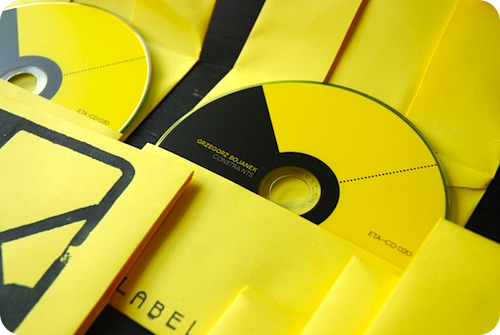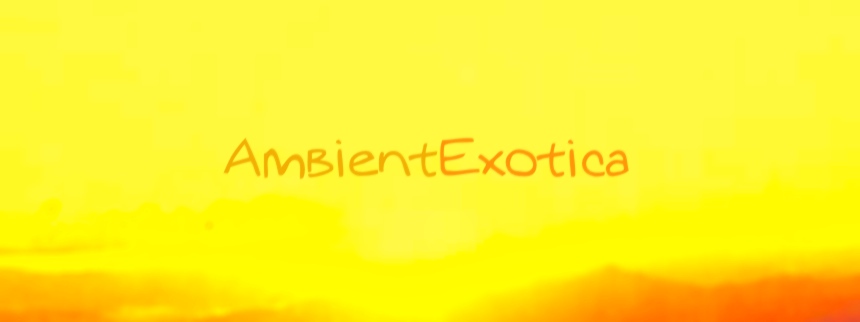
Grzegorz Bojanek
Constraints
2013
An album title such as Constraints is a bold statement. And, as it turns out, rarely 100% astute. Polish Ambient artist and ETALABEL runner Grzegorz Bojanek falls into the same trap with his eponymous album, but what sounds like a first attempt to pan the concept of the album is anything but a respectful nod towards the artist’s interpretation of minimalism and, well, constraints. Comprising 12 tracks plus a bonus track, released in July 2013 on his ETALABEL and available to purchase at Bandcamp, Constraints comes in a handmade yellow digipak edition with artwork by Mateusz Bąkała and a carved out woodcut off the graphics which are quasi-stamped onto the covers. It is also an album that was never meant to be. The tracks were loose entities in their original habitat on SoundCloud, uploaded by Bojanek in order to take part in Marc Weidenbaum’s Disquiet Junto group, a collective of electronic musicians that use constraints (!) to achieve layer entanglements that become bigger than the sum of their parts. This is exactly the label runner’s point of intersection: Constraints does not sound desiccate or emaciated, but wide and fleshed out. Sure, there are elements of Glitch aplenty on this album, from crackles over clicks to jitters, but these are only embellishments which orbit around soft metallic and stealth-like surfaces as well as organic field recordings of forests and gardens. Krzysztof Orluk mastered the release and added an unspecified amount of warmth into the songs, so that the work never emits a clinically sterile emptiness. There is another big twist, a glaring particularity – I would even go so far as to call it a peculiarity – found in Constraints, and it comes in the shape of acoustic guitar chords. Sure, Drone fans have heard them before and will encounter them time and again, but on two tracks, Bojanek succumbs to Dream Pop formulae and unchains a euphoric effulgence that gleams like a rainbow. What are the constraints in these very pieces? And how can a mélange of various tracks harmonize with the album format? These and other questions are answered in the following paragraphs.

A detailed look at the digipak artwork as photographed by Grzegorz Bojanek.
The opener We Are All Red Green And Blue is the gateway to the coruscating glitz of Grzegorz Bojanek’s Ambient spheres, and even though the term glitz is highly dubious and only outshone by the totally different and audacious glam, I for one find it fitting enough, for the cosmic coils and icy streams radiate brightly, but inherit an energetic vibe that conflates well with the Crime Jazz-like double bass-resembling bass blebs. These are further illumined by heftily vesiculating glints and pops. Pentatonic acoustic guitar twangs resemble the thermal heat of the Orient and leave a bedazzled reviewer behind: is it a cold, shady or even warmhearted Ambient track? Its interstitial structure carries various emotions. A great opener! The follow-up Three Is Enough is much warmer and enchanting, as Bojanek ventures into a crystalline antrum of soft haze banks, glistening chimes and open air field recordings. Another mystery builds up: cavernous reverberations in an open field? Electronic music makes it possible. While My Mind Between The Walls fathoms out the sanguine-rufescent sunset rurality of warped bonfire guitar licks, fire crackles and increasingly bustling aquatic-ligneous droplets, That Day Remained In My Mind benefits from higher volume levels as the twilight guitar chords then become eminently punchy and staggering. The added retrogressive Hammond organ-like gong spirals, the soft static-noise perturbed backdrop as well as the gorgeously upwards wafting synth-oid jingles create a contemplative Far Eastern piece. Another strong favorite of mine, as it mixes earthbound gravity with galactic nebulae.
All Four Seasons remains in spacier climes, or so it seems, as it actually depicts an enchanted chaparral of chirping birds, nearby roads and a progression towards noisier environments which are nonetheless surprisingly fitting and silkened. It is still implied that trees are falling down. This is one of the darker undertones in Constraints that can actually be transparently linked to an unambiguous incident. Alone is next and comprises a wondrously bit-crushed circumambience of granular harmonicas, bag pipe-like protrusions and clinging plates or similar curlicues. It is the contemplative kind of isolation this tune depicts, not the devastating one, although the harmonica tones evoke that certain wilderness which boggles the mind of city strollers. Like a thunderbolt, however, does the following One Hot Day feel due to its unvarnished vivacious Pop placenta: oversaturated, extremely catchy Dream Pop guitar chords are twirling in a heliosphere filled with tape hiss. Glorified, transcendent and moving ever-forward, Grzegorz Bojanek ameliorates the catchy strumming with sizzling afterglows and spectral reverberations. This is the one song that does not fit in the overall scheme, but its powerful impetus is utterly welcome!
The perniciously titled Garbage is coming up next and is a piece of high plasticity supercharged with asbestus whirlpools, cautiously blown bottles that bring back childhood memories and partly analog, partly digital noise specks, all of them comparably mellifluous and well-balanced, even though the white noise alloy increases near the end. Whereas Drops transforms its title into alkaline driblets on brazen surfaces in front of a background of prolonged metallic echoes and can therefore be interpreted as a texture-focused vignette, My Garden features even less alatoric tone sequences and prefers to present another field recording upon whose base frame digital augmentations such as turbulent cyber storms and hollow bubbles are grafted. The depth and abyssal movements of these gales contain a large wideness. Add the vehemence of the wind force to the mayhem, and you got yourself a raucous brute that still manages to feel semi-dulcet. The addendum to My Garden is called Listening To Birds which is surprisingly enough not based on another field recording but transforms Bojanek’s observations into a Beck-worthy Folk guitar arrangement. It is what I would call the “common” composition of this album with the least amount of digital aftereffects. The finale Warm Autumn then unleashes mellow drones of heavily reverberated, golden-shimmering guitar flumes in adjacency to an incisive harmonica-piano couple which altogether depicts another sun-soaked euphony, with the hidden bonus track Violet World rounding off the album by presenting a glacial Thomas Köner-worthy panorama charged with repeated mean-spirited three-note sequences which resemble robotic pianos. A crestfallen wasteland that presents another large stereo field.
It is astonishing how well all of the 13 pieces work together; not that Grzegorz Bojanek would not be able to create an overarching set of rules that is applied to all tracks. But the crux lies in the fact that this collection of tracks was never meant to appear on one single album, at least not in the initial stages of Bojanek’s work phase. With the words of the artist himself, “so far I’ve created several tracks for the Disquiet Junto group and they are free to download from my SoundCloud profile. Still, I wanted to publish them as an album, because I feel that they should exist also in a physical form.” Now they do. What this quote does not reveal is how stable the atmosphere remains throughout the album. Even though there are field recording-based vignettes, adamantly catchy guitar-fueled segues and Glitch-interspersed texture turmoils where vertiginous-vestigial melodies whirl in the distance, the album feels like an album, a coherent work, as strange this may seem at first, for the Pop-oriented pieces are shimmering like iridescent diamonds. Equally shimmering, but in gunmetal colors, are tracks like the opener We Are All Red Green And Blue as well as Drops and Garbage. A meaningful revelation is also implied in the layers and strata one could summarize under the universally acclaimed term that is noise. It means many things to multitudinous people, but Bojanek manages to soften the harshness, to make the noise levels almost mellifluously translucent. Oddly enough, the harmonica tones in Alone are much more piercing than the good old-fashioned gallimaufry of steel, metallic splinters and cold shards. The Polish sound artist’s minimalism is so cleverly realized, the texture pools so well chosen that the album title Constraints is almost de trop. This is the only field where Grzegorz Bojanek has failed. Which does not say much. Or anything at all.
Further listening:
- You can purchase the full album and stream 12 tracks (but not the bonus track) at Bandcamp.
- Follow Grzegorz Bojanek and his label on Twitter: @ETALABEL.
Ambient Review 260: Grzegorz Bojanek – Constraints (2013). Originally published on Sep. 11, 2013 at AmbientExotica.com.
